How to make a heating register with your own hands: assembly and installation instructions
Heating radiators are elements of engineering plumbing systems that are functionally designed to heat indoor air. According to SNiP (2.03.01-84), radiators corresponding to the calculations of the heat balance should be used in any room. To maintain a normal temperature inside the buildings, they are quite enough.
However, for a garage or a small workshop, it is better to make a heating register with your own hands. In terms of dimensions and heat transfer, this device goes beyond the parameters of classical designs, but it is much more suitable for these rooms. The article we presented details the technology for its manufacture.
The content of the article:
Homemade heating registers
By increasing the heat transfer area and the volumetric component of the coolant, of course, it is easier to achieve the desired temperature in the room. Therefore, quite a lot of property owners, taking advantage of the lack of heat control at each specific point, increase their heat removal by manufacturing radiators of non-standard designs.
In fact, this is prohibited, as it seems to be an irrational approach to the consumption of energy resources. In practice, they think less about resources than about their own well-being. With options for economical garage heating will introduce next article, the contents of which we advise you to read. However, closer to the point.

Making a heating register with your own hands is a relatively simple task, especially if you have the skills of a welder and have a welding machine at hand. It remains only to purchase in the right amount of pipe of suitable diameter and sheet metal.
How to calculate the heat transfer?
The required amount of material can be calculated based on the temperature parameters that are required to be obtained indoors.At the household level, this step is usually skipped - do the heating registers with their own hands "by eye" on the principle of "the more the better."
But it is better to make simple calculations of heat transfer, for which you do not need to be a mathematician. It will only be required:
- Calculate the area of the room.
- Learn about the heat transfer properties of steel.
- Choose the optimal pipe diameter.
The area of the room is calculated by multiplying the size of its length by the size of the width (S = L * W). However, for more accurate calculations, it is recommended to calculate the volumetric parameter by adding the height value (H) to the calculations.
So, the final calculation formula takes the form:
V = L * W * H
For example, it is required to calculate the V premises, where the length is 5 m, width 3 m, height 2.15 m. The volume of the room is obtained: V = 5 * 3 * 2.15 = 30.25 m3. Based on this basic value, further calculations should be made that determine the amount of heat, dimensions and the number of heating registers for DIY manufacturing.

First of all, the required amount of heat is calculated per the calculated volume of the room to achieve the required internal temperature (W):
Qpt.t = V * k (Tvn - Tnar),
where V is the volume of the room; k is the heat transfer coefficient of the walls of the building; Tvn is the temperature inside; Tnar is the temperature outside.
The amount of heat generated by one register can be calculated by the formula:
Qp = q * L * (1-n),
where: q is the heat flux from each horizontal and vertical pipe of the register (approximately 20-30 W / m); L is the length of the vertical and horizontal tubes of the register (m); n is the coefficient of unaccounted heat fluxes (for metal pipes - 0.1).
The category of unaccounted heat loss also applies hood in the garage. If a mechanical type is installed, the coefficient n needs to be increased to at least 0.2.
The number of registers, respectively, is determined by the formula:
Nр = Qpt.t. / Qр
Such a calculation methodology by design specialists is likely to be evaluated as a simplified and crude form. However, this approach is still seen as a more rational action than calculation and manufacturing of registers do it yourself by eye, without any calculations.
Heater configuration selection
Homemade radiator designs are mainly made on the basis of metal pipes with a diameter of 80 - 150 mm.
Design features are limited to two versions:
- Lattice.
- The snake.
The lattice design of the heating battery differs from the “snake” in a slightly different construction of the circuit, and, depending on the variations in such batteries, the distribution of the coolant can be different.

The coil designs are actually of a uniform design, which assumes a strictly consistent movement of the coolant.
Lattice registers are built according to different schemes:
- with one or two jumpers and one-way power supply;
- with one or two jumpers and versatile power;
- parallel connection of pipes;
- consecutive inclusion of pipes.
The number of pipes of one assembly can be from two to four or more. Rarely, but there is also the practice of manufacturing single-tube registers.
The coil assembly usually contains at least two pipes connected on one side by a blind bridge, and on the other a through bridge, which are made of two pipe bends (2x45º). It should be noted that the execution of heating registers in the form of a coil is used much less frequently than the design of the "grid".

Both manufacturing options - lattice and serpentine - can be made not only on the basis of classic round, but also on the basis of profile pipes.
Profile pipes are seen by a somewhat specific material, since they require a slightly different approach when assembling heating radiators. However, the registers from the profile pipe are more compact and take up less usable space, and this factor is also important.
Radiator Instruction
In order to make a heating register with one's own hand, it is recommended to initially carry out the necessary calculations (the procedure is higher in the text). And the point here is not in saving resources, but in making batteries that are really useful in every way.
To survive the winter period with open windows - this option is suitable for "walruses". Everyone else who is not part of a group of seasoned people runs the risk of getting a serious cold. And powerful heating batteries are just as bad as too weak.
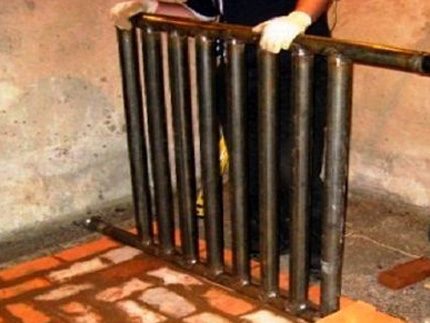
So, the calculation is done, you can proceed to the selection of material.
An economical and quite suitable choice for a home-made design can be considered steel pipes and manufactured for steel pipe fittings to them:
- bends (suitable to the diameter of the pipes);
- corners (fittings);
- steel sheet (thickness equal to pipe wall thickness);
- branch pipes (pipes of small diameter).
Valves may also be required, which are often not directly placed on registers. Manufacturing skills and knowledge would be useful gas welding technologyif the future performer possesses them.
Pipe preparation and welding
According to the calculated length parameters, the pipes of the future radiator are cut to size. A convenient tool for cutting is a circular saw. Then, plugs are cut from the metal sheet at the ends of the pipes. The round shape of the plug is conveniently cut with an oxygen cutter.
First of all, circles of the desired diameter are marked with chalk on the surface of the metal sheet and then carefully cut. Part of the sliced pancakes (the amount is calculated) is made with holes for the inlet and outlet of the coolant.
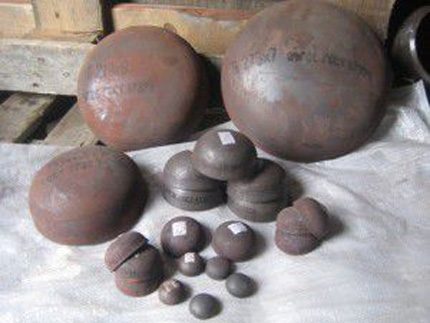
It is also immediately recommended to cut holes (one or two, depending on the assembly project) in the wall of each pipe, with a distance from the end edge of 100 - 150 mm. These holes are designed for pipe through pipe connections during battery assembly.
After cutting holes, it is recommended to clean the inner area of each pipe from slag and scale. Next, they put pancakes on the ends of the pipes and qualitatively scald them in a circle. On the first and last pipe, one pancake with a hole is welded.
Assembling a heating battery
Finished pipes must be combined into a battery. To do this, they are determined with the configuration of the radiator (if it is decided to make a lattice structure). Based on the accepted configuration choice, jumpers are prepared - walk-through and deaf.
The material for the jumpers are usually pipes of small diameter. For example, d = 25 mm or d = 32 mm. Tubes for feed / return pipes are also prepared (length 150 - 200 mm, diameter 25 - 32 mm).

Pipes prepared for the heating register (2 - 3 - 4) are laid out on a flat surface, aligned at the end edges. The first (upper) and last (lower) are laid out with end edges with holes, according to the selected connection scheme: one-sided (input and output on one side) or two-sided (input and output on opposite sides).
It remains only to carefully breach the passage and blind plugs between the pipes, the inlet and outlet pipe, after which the heating register is ready for installation in the system. Before work, a novice master will need to study electric welding rules, described in detail in the article devoted to this issue.
Design Features "Snake"
The coil register is assembled a little differently. Here, instead of vertical jumpers, metal bends are used to connect the end parts of individual pipes.
To build a register with a snake, you must:
- Lay pipes on a flat surface.
- Weld from 45 ° twin taps to arc taps.
- Connect the pair pipes of the register on each side with arc taps.
- Close the start and end end of the first and last pipe with plugs and nozzles.
Coil heating registers are made large by limiting the possibility of adjusting the annulus. In this regard, "snakes" outperform lattice structures. However, from the point of view of the efficiency of the coolant, the "snake" seems to be the preferred option.
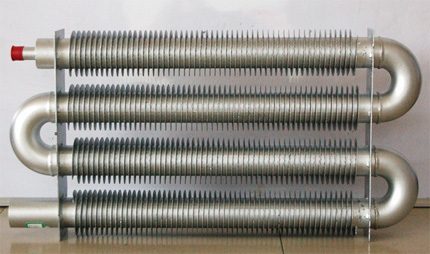
Inside such registers, air traffic jams practically do not form, which is typical for products of the “lattice” type. Moreover, thanks to the arc bends of large diameter, coil designs have less hydraulic resistance. Nevertheless, doing such registers with their own hands is quite rare.
The difference between profile registers
An interesting design compared to the ones described above is a register made of a profile pipe. More compact, but no less efficient batteries are assembled practically using the same technology.
The assembly features can only be noted the preparation and fitting of the annular bridges. As a rule, welding is not used here. It’s enough to have a good metal cutting tool.
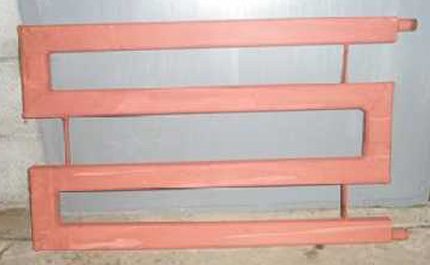
The ends of the annular bridges and directly register pipes are cut at an angle of 45 °, achieving exact coincidence along the faces on the connection line. If a register of the “lattice” type is being assembled, the annular jumper is made with angular cuts at the ends and straight cuts at the points of supply of the central pipes.
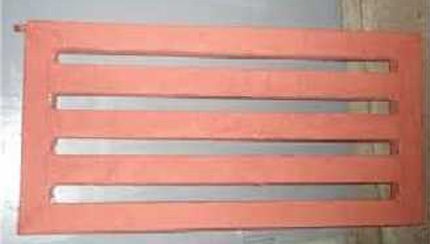
After preparation, the jumpers are put in place and neatly scalded. On the "snakes" additionally put blind reinforcing jumpers parallel to the passage.
Home-made registers were widely used for domestic needs in the recent past. Now this type of heating device is used less often.
An alternative to registers, especially if the garage is not connected to a central heating system, will serve miracle diesel fuel stove. The method of its manufacture will be introduced by the article we have proposed.
Conclusions and useful video on the topic
You can learn about the sequence of manufacturing a heating register from a profile pipe and welding secrets from the video:
Home-made heating equipment is actively continued to be made and operated in rural areas or in private plants for heating office technical premises. But many refuse to use such irrational facilities, especially where metering and control devices for coolant consumption are being introduced.
Want to talk about how to assemble a register for a garage or a summer residence with your own hands? Do you have information that can be useful for independent home masters? Please write comments in the block below, share useful information and photos on the topic of the article, ask questions.

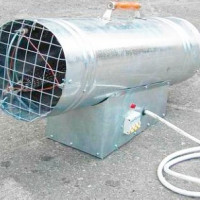 Do-it-yourself heat gas gun: step-by-step assembly instructions
Do-it-yourself heat gas gun: step-by-step assembly instructions 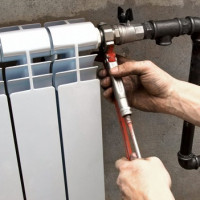 Installing heating batteries: do-it-yourself technology for the correct installation of radiators
Installing heating batteries: do-it-yourself technology for the correct installation of radiators 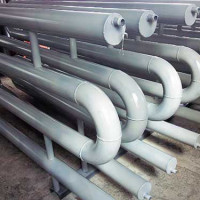 Heating registers: types of structures, calculation of parameters, installation features
Heating registers: types of structures, calculation of parameters, installation features 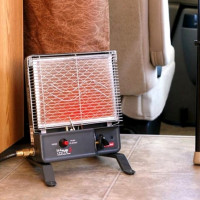 How to make a heater yourself: instructing on the manufacture of a homemade device
How to make a heater yourself: instructing on the manufacture of a homemade device 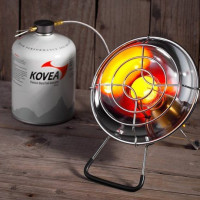 Homemade heater for the garage: how to make a device yourself
Homemade heater for the garage: how to make a device yourself 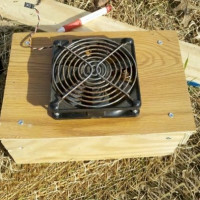 How to make a fan heater with your own hands: a briefing on the manufacture of a homemade device
How to make a fan heater with your own hands: a briefing on the manufacture of a homemade device  How much does it cost to connect gas to a private house: the price of organizing gas supply
How much does it cost to connect gas to a private house: the price of organizing gas supply  The best washing machines with dryer: model rating and customer tips
The best washing machines with dryer: model rating and customer tips  What is the color temperature of light and the nuances of choosing the temperature of the lamps to suit your needs
What is the color temperature of light and the nuances of choosing the temperature of the lamps to suit your needs  Replacement of a geyser in an apartment: replacement paperwork + basic norms and requirements
Replacement of a geyser in an apartment: replacement paperwork + basic norms and requirements
They also made a register in the bathroom, we have it big, more than 15 squares. In order not to put two batteries, they decided to simply install one large register, which they themselves welded. In general, there is nothing complicated, the main thing is to know how to do it. So, before cooking, read on the Internet a detailed briefing. It turned out, by the way, not bad, it heats up perfectly, an air jam has never formed.
Registers, of course, are a good thing, especially if there is material for them. I found copper sheet in the attic of my father and made such a small register. The copper pipe coil with the plumage of copper, like a radiator in an air conditioner, only has a larger diameter.
Heat dissipation is super. True, you understand, he has a vidoc from the series "handmade, made with an ax." I put it in the bathhouse, it fit in there normally, the most important thing is that it’s warm, and I didn’t spend money on the material.